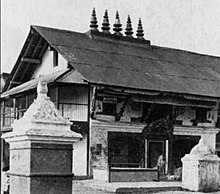Sankata Temple
This article needs additional citations for verification. (February 2016) |
| Palah: Dya | |
|---|---|
पाला: दयो | |
 Palah: Dya in 1960s | |
| Religion | |
| Affiliation | Hinduism |
| District | Kathmandu |
| Deity | Chanda Maharoshan or Achala(immovable one) |
| Festivals | Navaratri, Dashain |
| Location | |
| Location | Te Bahal |
| Country | Nepal |
| Geographic coordinates | 27°42′8.57″N 85°18′43.74″E / 27.7023806°N 85.3121500°E |
| Architecture | |
| Creator | King Gunakama Dev |
Palah: Dya (Nepali: पाला: दयो), is one of the temples located at Te Bahal, Kathmandu, Nepal. Palah: Dya is a popular divinity who is worshipped, especially on Saturdays, to ward off bad luck and sickness.[1] Palah Dya is worshipped by Buddhist as well who accredit the shrine to Chanda Mahoroshan. [2]
This shrine along with Mahankal Than and Lumadi than are worshipped together on a single day.[1]
History/Legend
[edit]Legend has it that during the rule of the Malla King Narendra Dev, a Gubhajyu, a Buddhist Vajrayana Guru, skilled in Tantrik practices, called Bandhu Ratna Bajracharya, with the permission from the king, used his Tantrik powers and brought Sankata and Yogini into two different holy pitchers and worshipped them. Later, a temple for the goddess was established during the reign of King Gunakama Dev.[2] Even today, every 12 years, the priest of the temple, a Buddhist Gubhajyu of the Newa Bajracharya clan, worships the deity in a holy pitcher along with another pitcher for Yogini at the Katuwal Daha at Chobhar and then the goddesses are enshrined in the temple.
According to cultural expert Indra Mali, who grew up in Te Bahal, Palah: Dya is not originally from Kathmandu. There's another legend that states Palah: Dya, as Buddhists call the deity, was brought from Kamaru Kamachya (the present Kamakhya) in Assam. Palah: Dya later became widely known as Sankata.
Rituals & Festivals
[edit]The deity is worshiped by following secret Tantrik rituals. The priest must not be touched at the temple, nor must the statue of the deity. The statue of the deity is draped in cloth covering her body except for her head because the deity is secret Vajrayana deity which shouldn't be seen by the people who don't have the initiation of the deity. Devotion to Palah: Dya is commonly believed to ward off troubles and bad omens from one's life. Although religious rites are carried out every day, the temple is frequented mostly on Saturdays, or on one's birthday. Everything required for worship is available right outside the temple. One can also ask the priests to do some puja for placating one's unfavorable planets and stars. For that, one will have to have oil, iron, black cloth and black lentils. Every 12 years, the priest of the temple, a Buddhist Gubhaju of the Newa Bajracharya clan, worships the deity in a holy pitcher along with another pitcher for Yogini at the Katuwal Daha at Chobhar and then the goddesses are enshrined in the temple. The route of the 12 years jatra is kept secret.
References
[edit]- ^ a b Kathmandu Valley - The Preservation of Physical Environment and Cultural Heritage - A Protective Inventory by Carl Pruscha, Vol. 2, Wien 1975
- ^ a b "The Sankata Temple at Te Bahal". www.myrepublica.com. Archived from the original on 2015-12-22.

